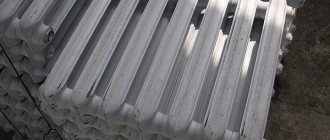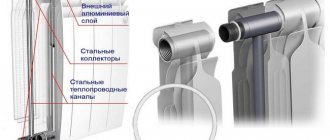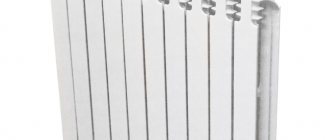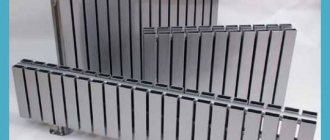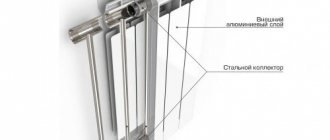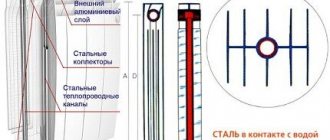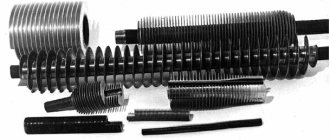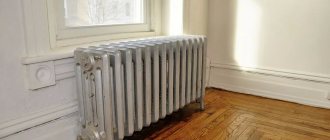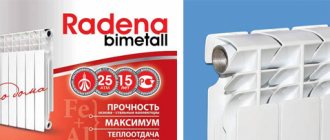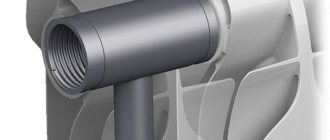Invented and invented in the recent 19th century, cast iron radiators still do not lose their popularity among consumers. Even without looking at the appearance of more modern models on the market (aluminum, steel, bimetallic, etc.), they are still an integral part of a large number of heating systems due to the benefits and performance they provide.
- 1 Crimping and operating pressure
- 2 Service life
- 3 Power and heat dissipation
- 4 Coolant for cast iron radiators
- 5 Positive and negative aspects
- 6 Calculate the power of a cast iron radiator 6.1 Video instructions for assembling sections
Let us briefly list the main technical characteristics of cast iron heating radiators, after which we will dwell on them and other features of similar models in more detail:
- Weight of one section – from 3 to 7 kg
- Section depth – from 7 to 12 cm
- Section width – from 8 to 10 cm
- Section height – from 37 to 57 cm
- Internal cavity volume – from 0.7 to 1.5 l
- Working pressure – up to 18 atmospheres
- Section power – up to 200 W
- Service life – up to 30-50 years
Design features
It is worth dwelling on the design features of the models offered on the modern market. They are made from a homogeneous and strong cast iron alloy. The products are widely used in private or industrial autonomous and centralized heating systems.
A cast iron radiator can consist of any number of sections that are easily connected and separated from each other. This allows you to install devices in the premises, the power of which is sufficient to heat the entire area. To prevent leaks, sealing gaskets made of rubber or other materials are used at the connecting points.
According to the principle of operation, cast iron heating radiators do not differ significantly from modern analogues. The coolant, which is heated in the boiler, releases its heat into the room through the battery. The market offers models with 1, 2 and 3 channels.
Technical characteristics of cast iron radiators
Almost every home has cast iron radiators. Manufacturers improve them over time and improve their technical characteristics. There are steel, aluminum and other radiators on the market. But the most popular radiators are still cast iron. This is due to the many advantages and performance indicators of such heating devices.
Content
1. Features of cast iron radiators 2. Advantages and disadvantages 3. Types of pressure 4. Which coolants are suitable for cast iron radiators 5. Main characteristics 6. Service life 7. Heat transfer and power 8. Calculation of the power of cast iron radiators
Manufacturing radiator tests with trial pressure
Today, the production of radiators for water heating systems in terms of developments, design features of products, technologies and materials used is not inferior to high-tech fields such as mechanical engineering, and sometimes even surpasses them. Indeed, despite the apparent simplicity of the form and operating principle, radiators must meet the most stringent requirements. And they concern not only the effective transfer of heat from the coolant into the room, but also ensuring a long service life, which is directly or indirectly influenced by various factors - sudden temperature changes, excess pressure, aggressive coolant environment, local power loads due to violation of installation rules and etc.
In addition, taking into account the practice of using heating equipment poses new challenges for developers. In particular, the issues of ensuring a comfortable microclimate in each room by eliminating excess heat, effective redistribution and use of all thermal energy, saving energy resources, and introducing automatic control systems are becoming increasingly relevant. Their solution is possible by supplying radiators with individual means of adjusting heat transfer - thermal valves, thermostatic regulators, smart sensors, etc. Not every radiator is suitable for using such devices. This is due to the fact that the device must quickly change the heat transfer parameters depending on the values set on the control elements. It is advisable to supply these elements only to radiators with low inertia.
Following the requirements of the time, the manufacturer of heating devices takes into account all these particular and general wishes in its products. At the same time, it uses both accumulated production experience and unique new developments, the latest achievements, incl. from other areas - robotics, chemical industry, instrument engineering, etc.
Trends and prospects for the production of heating devices are inextricably linked with the constant increase in their manufacturability
The given pace of improvement of the technical characteristics of radiators means for the manufacturer not only the introduction of design changes while maintaining established standards of appearance, not only the use of advanced technologies, automation systems and the use of high-precision equipment, but also compliance with new requirements for quality control at all stages of manufacturing - from the selection of the original material before shipment of finished products to the customer. Control is established for the chemical composition of raw materials, melting, mechanical properties, threaded and welded connections, thickness and quality of painting, surface roughness, packaging parameters, storage conditions and much more. Controls must also be continually reviewed. Therefore, the production of a modern heating device is impossible without a complex of quality control.
The production of radiators is regulated by GOST 31311-2005 “Heating devices” [1]. In particular, according to clause 5.2, heating devices must be durable and sealed, and withstand a test pressure of water or air that is at least one and a half times the maximum operating pressure, but not less than 0.6 MPa. To monitor compliance with this requirement, the manufacturer uses special test benches. The maximum operating pressure must be indicated in the radiator data sheet [1, 2].
Features of cast iron radiators
Cast iron radiators appeared in our country only in the last century. The first city in which such a heating device was seen was St. Petersburg.
Such radiators are made from a fairly strong cast iron alloy. This material is very durable. Cast iron radiators are used both in residential buildings, industrial buildings, and in centralized heating systems. The battery can consist of any number of sections. This allows you to install the appropriate device for each room. For a small area, the power of a small radiator is enough, so it would be inappropriate to use a multi-section heating device. To avoid leakage, sealing gaskets made of rubber or other materials are used at the junctions of sections.
Cast iron radiators do not differ in the nature of their operation from steel or aluminum ones. The coolant is heated in the boiler and transfers its heat using a heating radiator. There are several models of cast iron radiators: with one, two or three channels.
Connection
Fitting
How to properly connect a cast iron battery with your own hands? Traditionally, to connect heating appliances, pipe connections are used; the connection is ensured by a radiator plug and locknut. The connection is sealed by wrapping it with plumbing flax (preferably with paint or silicone sealant).
Connection on the lines.
The radiator installation instructions are as follows:
- A lock nut and plug are screwed sequentially onto the long threads of the connections;
- The radiator is hung in such a way that the hoses are aligned with its collectors and extend into them by 2 - 3 centimeters.
- The plugs are wound up and driven along the connections, screwed into the threads of the outer section.
- Then they are tightened with locknuts - also, of course, with winding.
Recently, however, American ones have begun to be used much more often for installation - detachable fittings with union nuts.
Connection on American.
In this case, the installation looks different:
- The tap with the American connection is mounted on the supply line coaxially with the battery collector.
- The American counterpart is screwed into the radiator plug.
- The union nut is tightened and tightened with an adjustable wrench with moderate force.
Useful little things
It's helpful to remember a few things when installing.
The efficiency of cast iron radiators (let's call it the ratio of their real thermal power to the rated one) will be maximum with the following connection diagrams:
- When the number of sections is up to 10 - side;
- When the number of sections is over 10 - diagonal.
Diagonal connection.
Silting of the battery can be avoided by connecting it from the bottom down. The continuous movement of the coolant through the lower collector will not allow deposits to linger in it. In other cases, it is advisable to equip the lower blind plug with a flushing tap.
Please note: this applies to cases where cast iron heating devices operate in a central heating system. In an autonomous circuit, all suspended matter quickly collects in a mud pan and does not create problems in the future.
Speaking of the declared power: manufacturers give its values for the temperature delta between the coolant and the air in the heated room at 70 degrees (for example, 90/20C). Reducing the delta by half entails, as you might guess, a twofold drop in heat transfer.
Advantages and disadvantages
Advantages:
1. Cast iron batteries can withstand temperatures up to 150°. Such radiators resist corrosion well. Cast iron is difficult to corrode.
2. The radiator walls are made very thick. Therefore, such batteries have a long service life. Radiators can be used in an open heating system and one that is occasionally emptied. Steel radiators under such conditions would become rusty in a few years or completely unusable.
3. Due to the large cross-section of the battery, they can be cleaned less often, unlike other radiators.
4. If a cast iron radiator is made according to all standards and from high-quality material, then it will last a very long time. It is possible to use a radiator for up to 50 years, and sometimes up to 100 years.
5. Such radiators are difficult to damage or dissolve.
6. When the radiator is turned off, it will continue to heat the room by 30%. Cast iron batteries have heat transfer several times greater than radiators made of other materials. In case of irregular heating of the coolant, a battery made of cast iron will cope with its function perfectly. All these qualities are possible thanks to the good heat-storing properties of the cast iron battery.
Flaws:
1. Heavy radiator weight. When lifting the radiator into the apartment, it will be problematic to bring it.
2. The working pressure is much less than other radiators.
3. Due to the number of sections, the surface area of the radiator is reduced. It is smaller than other radiator models.
Along with all the advantages, the disadvantages are insignificant.
Pressure standards in heating systems of private houses
Water heating of a private house, as a rule, consists of a boiler, distribution pipes, radiators (warm floor pipes) and auxiliary elements (expansion tank, safety group).
In open (gravity) systems with natural circulation, the static pressure does not exceed 1-2 atm.
To move liquid in closed types of heating, a circulation pump creates a dynamic pressure that is 0.5 atm higher than the static pressure, i.e. for a private house with a height of up to 10 m, 1.5-3 atm is considered normal.
All modern boilers and radiators can withstand this parameter with a margin. If the pressure increases for any reason, the emergency valve is activated, releasing a certain amount of coolant or steam formed in the system.
Modern boilers have a built-in emergency valve; when purchasing, it is important to find out the maximum pressure (indicated on the cap) for which it is designed, and when debugging the system, carry out adjustments (if necessary). By turning the adjustment knob, you change the characteristic at which the trigger will occur.
Adjustable spring safety valve. Most often used in individual heating systems.
Pressure testing of heating in private houses is carried out by increasing the pressure to 0.2-0.4 MPa (2-4 atm), which is 1.5 times more than normal working pressure. Boilers and expansion tanks are turned off for the test period, as they are the most susceptible to destruction.
An increase and deviation of the indicator by 15-20% from the norm indicates the appearance of a malfunction. The cause must be identified and eliminated as soon as possible.
Types of pressure
The pressure in such radiators is: pressure testing and working. The first is often called maximum.
The pressure test determines how much load the radiator can withstand during severe water hammer. When checking, they try to create a load in the highways that will be close to the maximum. This figure ranges from 12 to 16 atmospheres.
And the working pressure shows the load that the coolant gives in the radiator circulation. Typically the load is 9 atmospheres, but this figure can range from 6 to 9.
Working pressure and its differences
Now it’s worth comparing the operating pressure of two types of radiators:
Cast iron can withstand up to 12 atmospheres. This indicator is quite suitable for a heating system in high-rise buildings. At the moment of possible water hammer, the cast iron base can burst and crack due to its thin alloy.
Bimetal. The material is resistant to coolant pressure of 20 atmospheres. Some models reach 50 atmospheres. In the case of hydraulic pressure, the internal part of the battery, based on copper or steel, can withstand maximum loads. Only the areas where sections are connected are considered a weak point in such devices. Especially if sealant was used to connect them, and not gaskets or copper O-rings. In this case we are talking about cheap products.
What coolants are suitable for cast iron radiators
In such batteries, it is possible not to monitor the acidity values in the circulating liquids. This is due to the fact that such radiators are insensitive to coolants. Many impurities accumulate inside the central heating system. Due to the width of the channel, impurities can pass freely and not accumulate. This material does not enter into chemical reactions with liquids that contain antifreeze additives. But water treatment must be carried out, since in addition to the radiator, the coolant flows through the boiler, pipelines and other equipment.
Basic elements of the heating system
- Heating fluid boiler;
- a pump that circulates the coolant;
- an expander that eliminates the thermal expansion of the liquid in the system, and therefore the increase in pressure;
- automatic air vent, which is activated when the system becomes airy and releases air;
- shut-off valves that allow you to change batteries without removing coolant from the system.
We recommend: How to repair a cast iron heating radiator with your own hands?
Main characteristics
The main technical characteristics are:
- The depth of the section is usually from 7 to 12 cm, the width is 8-10 cm, and the height ranges from 37 to 57 cm;
- Working pressure reaches no more than 18 atmospheres;
- 200W is the power of each section;
- The radiator weight is quite large. The weight of each section can be from 3 to 7 kg;
- The section volume is 0.7-1.5 l;
- The average service life is 30-50 years.
- Radiators made of cast iron are superior to other batteries in many ways.
Heat dissipation and power
When considering the characteristics of radiators, you should learn more about battery power and heat dissipation. Usually the power of only one section is indicated. You will have to independently calculate the power of the radiator before installing it.
The heat transfer of cast iron batteries is much less than that of aluminum and other radiators. The heat transfer is approximately 2 times less. But thanks to its low inertia, cast iron remains warm longer and will release useful energy longer.
The power of one section of this radiator reaches a maximum of 160 W, and for example, for an aluminum section it is 200 W. The most profitable option would be to purchase a cast iron battery with natural coolant circulation.
Calculation of the power of cast iron radiators
There are several methods for calculating the required number of battery sections. There are several main factors that influence the required amount of power: the area of the heated room, the number and size of windows and doors, the material from which the external walls are built and the technical characteristics of the batteries.
There is a simpler option for calculating power. To do this, you need to multiply the area of the heated room by 100, and then divide the resulting number by the power of the section.
But there are some nuances that need to be changed:
- If more than one wall has borders with the street, then it is necessary to add several radiator sections;
- If the floor height is more than 3 meters, then add 1-2 sections;
- The value increases upward if the number is fractional;
- In a room with two windows, it is necessary to install 2 radiators with an equal number of sections, which was obtained as a result of the calculation.
Types of radiators by material of manufacture
The classification of radiators according to the material of manufacture can be considered the main one. Since it is the material from which the device is made that determines its most important characteristics such as heat transfer, sensitivity to the quality and chemical composition of the coolant (water), its weight and operating conditions.
Cast iron radiators
Cast iron radiators have been widely used for space heating for more than 100 years. Their persistent popularity and demand is quite understandable. Cast iron radiators are durable and highly resistant to difficult operating conditions. Cast iron is resistant to corrosion and insensitive to the chemical composition of the coolant. In the event of an emergency heating shutdown, such a product will retain the accumulated heat for a long time. Cast iron batteries can withstand pressure fluctuations in the system and water hammer. And the cost of a cast iron radiator is an order of magnitude lower than the cost of analogues made from other materials. However, this type of radiator has a number of significant disadvantages, which force many consumers to abandon cast iron batteries. The disadvantages of cast iron radiators include significant weight and bulkiness. High inertia does not make it possible to use cast iron radiators in modern systems with thermoregulation - cast iron takes a long time to heat up and takes a long time to cool down. In addition, today the appearance of any interior item is of great importance to the consumer. Cast iron batteries are not distinguished by a variety of designs and aesthetic appeal; they require regular touch-ups. Although in the manufacturers' proposals you can also find design options for cast iron radiators, often deliberately designed in a “retro” style. But this is the exception rather than the rule. Exclusive designer radiators are not suitable for every interior, and such a product will be quite expensive.
Aluminum radiators
The most popular today are aluminum radiators. Aluminum radiators are lightweight, compact, easy to install, aesthetically pleasing and look neat in interior design. The material is characterized by high heat transfer and low inertia, which allows the use of such devices in systems with temperature controllers. The sectional design of aluminum radiators makes it possible to assemble a device with the optimal number of sections for heating a specific room. The disadvantages of aluminum products include sensitivity to the chemical composition of the coolant - with a high alkali content in the water, such a radiator is especially susceptible to corrosion. An aluminum radiator requires air to be bled from the system using a bleed valve.
Steel radiators
This type of radiator is often installed in country houses and cottages with an autonomous heating system. A steel radiator is inexpensive and looks very attractive. Like aluminum, steel has high heat transfer and low inertia. Plus, the material is corrosion resistant. Steel radiators can be of tubular design or panel (consisting of one solid or several stacked plates). However, such radiators are practically not used for heating apartments in multi-storey buildings, since they cannot withstand water hammer and pressure drops in the system, and do not tolerate oxygen entering the pipes. The permissible coolant temperature for a steel radiator is no more than 110 degrees.
Bimetallic radiators
Despite the fact that bimetallic radiators appeared on the market relatively recently, this type of radiator is rapidly gaining popularity among consumers. Such a radiator consists of steel pipes through which coolant circulates and aluminum fins that transfer heat to the room. Thus, this type of product combines the advantages of steel (low susceptibility to corrosion and neutrality to the composition of water) and aluminum (strength, high thermal conductivity, aesthetic appearance). Such radiators are resistant to pressure drops and water hammer and can be used in any heating systems. The service life of a bimetallic radiator is at least 20 years. The disadvantages of such devices include the sensitivity of bimetallic radiators to the oxygen content in the system and the tendency to form slag deposits on internal surfaces over time. And also the high cost due to the complexity of the design.
